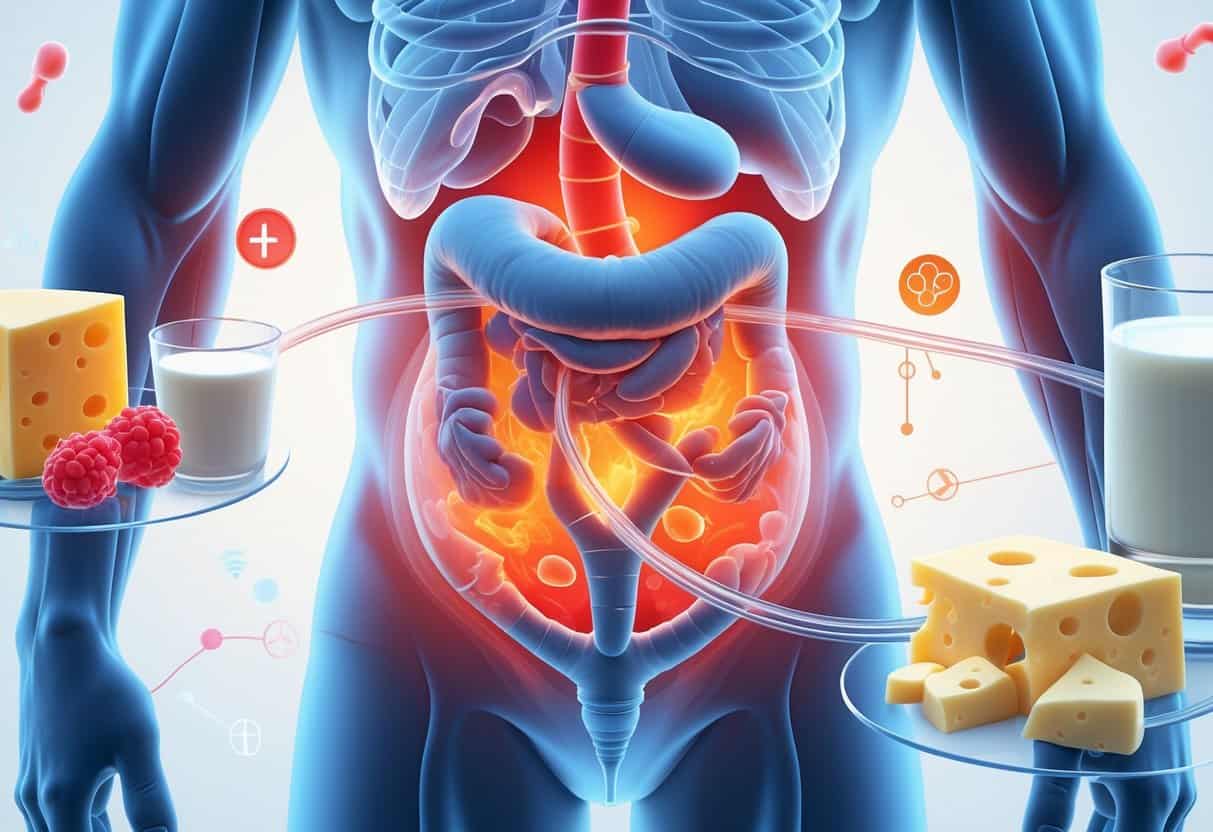A lot of folks with diabetes wonder if eating dairy might make inflammation worse, or just generally mess with their blood sugar. Surprisingly, most research says dairy isn’t inflammatory for diabetics—and might even be helpful.
Things like milk, cheese, and yogurt can fit into a balanced diet without making inflammation spike.

Dairy gives you protein, calcium, and vitamins—stuff your body honestly needs. Studies haven’t found solid proof that dairy makes inflammatory markers rise for people with diabetes.
Some research even hints that dairy could lower your risk of type 2 diabetes and improve certain metabolic factors. That’s not a free pass to eat unlimited cheese, but it’s reassuring.
Key Takeways
- Dairy isn’t shown to cause inflammation in people with diabetes.
- Including dairy can boost nutrition without making things worse.
- Some dairy foods might even lower type 2 diabetes risk.
Understanding Inflammation and Diabetes

First off, what is inflammation, and why does it matter if you have diabetes? Let’s break it down.
What Is Inflammation?
Inflammation is your body’s way of fighting off injury or infection. It helps heal you up and keeps invaders like bacteria in check.
But if inflammation sticks around too long, it turns chronic. That’s when it can start quietly damaging blood vessels and organs.
This kind of long-term, low-level inflammation doesn’t usually show obvious symptoms. Still, it’s linked to heart disease, diabetes, and other problems.
Inflammation’s Role in Diabetes
With diabetes—especially type 2—inflammation is a big player. Chronic inflammation messes with insulin, the hormone that manages blood sugar.
When your cells get less sensitive to insulin (thanks to inflammation), blood sugar rises. That’s the core issue in type 2 diabetes.
Managing inflammation could help your body respond to insulin better, making blood sugar control a little easier.
Systemic Inflammation and Metabolic Health
Systemic inflammation means your whole body is affected, not just one spot. It’s tied to metabolic disorders like diabetes and metabolic syndrome.
Metabolic syndrome covers things like high blood pressure, extra belly fat, and weird cholesterol numbers. If you’ve got systemic inflammation, your risk for these problems jumps.
Cutting down on inflammation can help your body handle sugar, fats, and blood pressure more smoothly.
Overview of Dairy Products and Their Nutritional Profile
Dairy comes in all shapes and sizes, with different nutrients depending on how it’s made and its fat content. That matters if you’re managing diabetes.
Types of Dairy Products
You’ve got milk, cheese, yogurt, butter, and cream. Milk is the classic, and it’s used to make most of the others.
Yogurt often has live cultures—good for your gut. Cheese? It’s all over the map in terms of texture, fat, and salt.
Whey protein shows up in some dairy. It’s a byproduct of cheese-making, packed with amino acids, and often found in supplements.
Nutrients in Dairy
Dairy’s got calcium, vitamin D, potassium, and protein. Calcium keeps bones strong, and vitamin D helps you absorb that calcium.
Protein, especially from whey, is good for muscles and might help with blood sugar. Dairy also has some fatty acids that could be heart-friendly.
| Nutrient | Benefit |
|---|---|
| Calcium | Bone strength |
| Vitamin D | Calcium absorption |
| Protein | Muscle repair, glucose control |
| Potassium | Blood pressure support |
| Fatty acids | Heart health |
Full Fat Versus Low Fat Dairy
Full-fat dairy’s got more saturated fat. That means more calories, but also fat-soluble vitamins like A and E.
Some newer research suggests full-fat dairy isn’t as inflammatory as people used to think. Low-fat dairy keeps the protein and minerals but cuts the fat.
Pick what fits your diet, calorie needs, and how you feel after eating different types. Honestly, both can work in a balanced diet if you’re paying attention.
Research on Dairy Products and Inflammatory Responses in Diabetics
Dairy and inflammation—it’s not a one-size-fits-all story. The kind of dairy and how it’s processed can change how your body reacts.
Key markers like C-reactive protein (CRP), interleukin-6 (IL-6), and adiponectin are all part of the picture.
Findings from Clinical Studies
Clinical studies don’t always agree, but here’s what’s out there: Low-fat dairy sometimes lowers inflammation markers like CRP and IL-6.
That could mean less risk for diabetes complications. On the flip side, full-fat dairy—with more saturated fat—might raise inflammation in some people.
It really depends on your health and what else you eat. Dairy proteins usually help with insulin sensitivity, so moderate dairy might actually help tamp down inflammation.
Differences Between Dairy Types and Processing
Low-fat milk and yogurt seem best for reducing inflammation. Cheese and high-fat dairy have more saturated fat, which can nudge those markers up.
Fermented dairy (like yogurt) might be even better, possibly thanks to the probiotics. Pasteurization and homogenization don’t seem to take away dairy’s anti-inflammatory potential.
Still, less-processed dairy could be a little better overall. Who really knows? The science isn’t settled.
Influence of Dairy on Inflammatory Markers
Dairy can move the needle on inflammatory markers. Lower CRP and IL-6 are good news.
Dairy also affects adiponectin, a hormone that helps with glucose and fat regulation. Higher adiponectin means less inflammation and better blood sugar.
If you go for more low-fat or fermented dairy, you might see those markers move in the right direction.
Dairy Consumption and Insulin Sensitivity
Dairy can change how your body handles blood sugar and insulin. There’s an interplay with body fat and certain fats in dairy that might matter for metabolism.
Effect on Glucose Homeostasis
Eating low-fat dairy could help keep blood sugar steady. Calcium and protein in dairy seem to help your body process glucose.
But it’s not so simple—too much dairy, especially with lots of saturated fat, could make your body less sensitive to insulin. That’s not ideal.
It really depends on the type and amount of dairy you eat.
Adipose Tissue and Insulin Resistance
Your fat tissue (adipose) is key in insulin resistance. If it gets inflamed, insulin resistance usually gets worse.
Calcium and other bioactive stuff in dairy might lower inflammation in your fat tissue. That could mean better insulin sensitivity.
Eat too much high-fat dairy? It could add to fat stores and worsen insulin resistance. It’s a balancing act.
Trans-palmitoleic Acid and Metabolic Outcomes
Trans-palmitoleic acid is a fat in dairy that might be helpful. Some research suggests it improves insulin sensitivity and glucose tolerance.
People with more of this fat in their blood often have less insulin resistance. Dairy with this fat could support better metabolism, but as always, moderation matters.
Dairy Intake, Obesity, and Metabolic Syndrome Risk
Dairy can play a role in body weight and metabolic syndrome risk. Some types might help with weight and factors like blood pressure or triglycerides—big deals for diabetics.
Impact of Dairy on Weight Management
Low-fat milk and yogurt are linked to a lower risk of being overweight or obese. That’s important since obesity is a big risk for metabolic syndrome and type 2 diabetes.
People who eat moderate dairy tend to have better weight control. Dairy’s protein helps keep muscle while losing fat.
Focusing on total dairy (not just full-fat) seems to be more helpful for weight. Low-fat dairy shows up as more beneficial in some studies.
Satiety and Caloric Intake
Dairy can help you feel full longer, thanks to its protein. That can mean eating fewer calories overall.
Feeling fuller could help you stick to a healthier diet and avoid overeating. That might lower risks linked to metabolic syndrome, like high blood pressure and high triglycerides.
Adding dairy to meals could be a simple way to keep hunger in check. It’s not a magic bullet, but it helps.
Dairy Products and Cardiovascular Health in Diabetics
Dairy can mess with your heart health in a few ways, especially if you have diabetes. It can change cholesterol, blood pressure, and blood vessel function.
Effects on LDL Cholesterol
Dairy has fats that affect LDL (“bad”) cholesterol. But moderate dairy doesn’t always push LDL up.
Some dairy, like cheese and yogurt, are linked to stable or even lower LDL in folks with type 2 diabetes. The type of fat matters.
High-fat dairy isn’t as risky as once believed. Low-fat dairy often has a neutral or positive effect on LDL. Protein-rich dairy can help your cholesterol profile, too.
Blood Pressure and Vascular Function
Yogurt and low-fat milk can help lower blood pressure. That’s probably thanks to calcium, potassium, and magnesium.
Better blood pressure means less heart risk. Some studies say dairy helps your blood vessels work better by reducing inflammation.
Eating moderate dairy could support healthy blood pressure and keep your blood vessels happy.
Dietary Recommendations for Diabetics Regarding Dairy
Dairy can fit into a diabetic diet if you’re thoughtful about what and how much you eat. Type and amount matter.
Current Dietary Guidelines for Americans
The Dietary Guidelines for Americans suggest low-fat or fat-free dairy daily. You get calcium and protein without too much saturated fat.
Go for milk, yogurt, and cheese—but watch portion sizes. They recommend 2 to 3 servings a day.
Skip the sweetened stuff. Added sugar in dairy can spike blood sugar. Stick with low-fat and unsweetened options for better diabetes control and less inflammation risk.
Personalized Nutrition Strategies
Your response to dairy isn’t quite like anyone else’s—it depends on your genetics, health issues, and even your daily habits. Try checking your blood sugar after eating different dairy products to figure out what actually works for you.
If dairy sits well with you, protein-packed options like Greek yogurt or cottage cheese could help with blood sugar. Some folks seem to do better with fermented dairy, which might calm inflammation a bit.
Consider talking to a dietitian about your dairy intake. They’ll help you tweak your diet so it fits your needs, aiming to lower diabetes risk and boost your overall metabolic health.